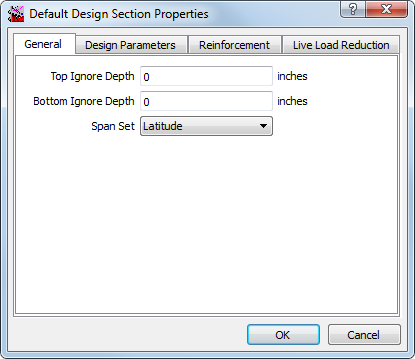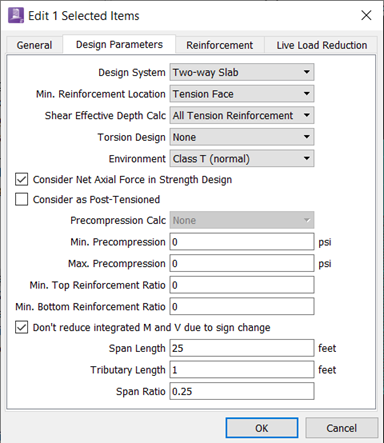Design section properties
Design sections have similar properties to design strips. See Span segment properties for definitions and explanations.
The following properties are unique to design sections:
| Setting | Description |
|---|---|
| Top Ignore Depth | The top concrete ignored in flexural and one-way shear design. See About ignore depths for more information on this important issue. |
| Bottom Ignore Depth | The bottom concrete ignored in flexural and one-way shear design. See About ignore depths for more information on this important issue. |
| Setting | Description |
|---|---|
| Span Length | Used to calculate the following: |
| Tributary Length | This creates a zone over which the reinforcement
required by the design section must be provided (development lengths, if
required, are in addition to this zone).
The intent of the span-ratio-based limit is to restrain the reinforcement zone to within the span, even if the design section is at the beginning or end of a span. |
| Span Ratio | Determines the location of the design section relative to supports and midspan. |
| Strip Type | (Eurocode 2 only) Determines the type of strip
defined by this design section.
The choices are:
|
| CS Service Design Type | (Eurocode 2 only)The service design type for
members defined as PT for the design strip.
See EN 1992-1-1: 2004 (Eurocode 2) With TR43 Design for additional information. |
| CS Crack Width Limit (Eurocode 2 only) | The crack width limit wmax to use when designing for Eurocode 2 clause 7.3. When "Code" is selected the values in UK National Annex Table NA.4 are used. |
| Number of Stories for Accident Design (Eurocode 2 UK NA only) | This input will only be visible when the Eurocode 2-2004 (UK Annex) is the active Design Code. It is used to determine the number of stories that are used for accident rule set calculations for this span. |


